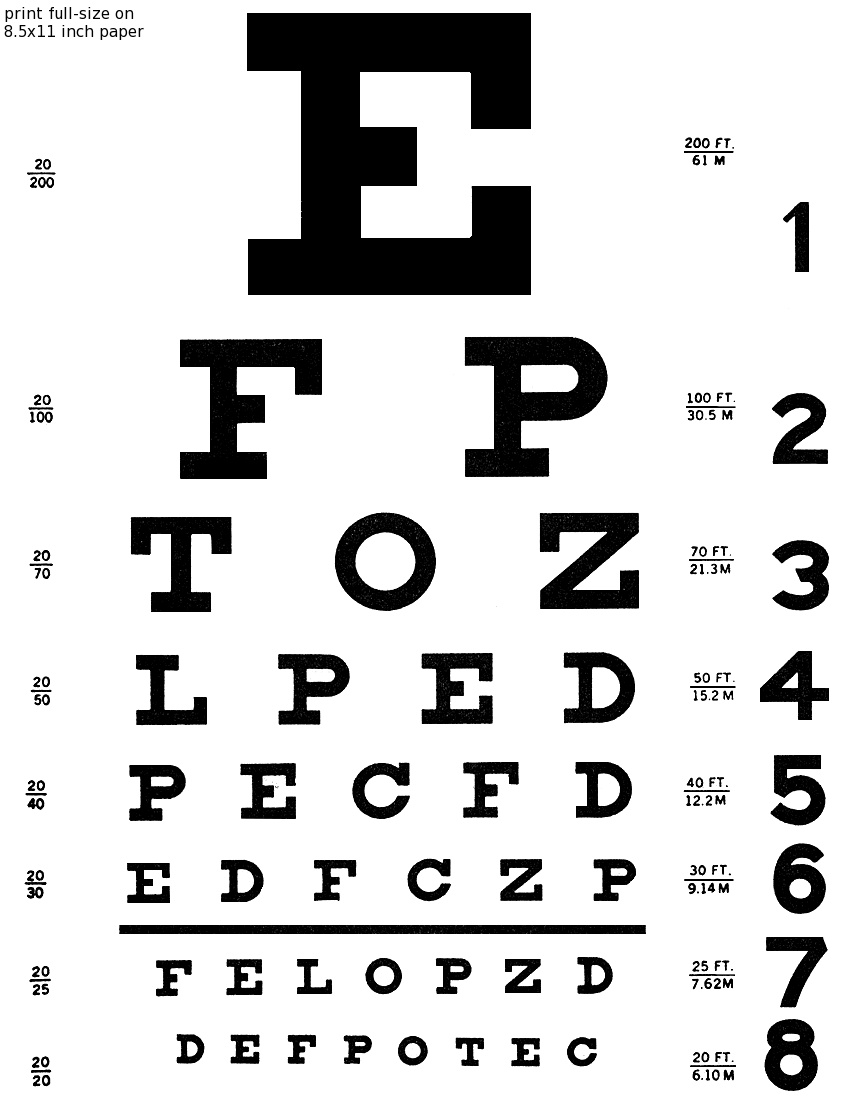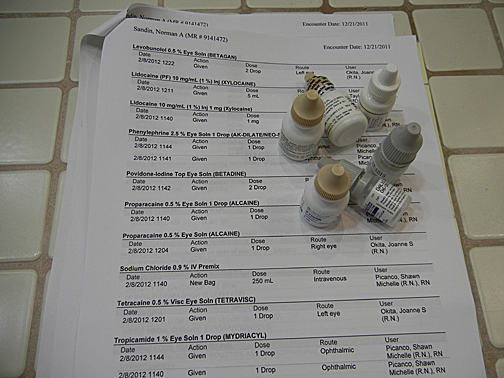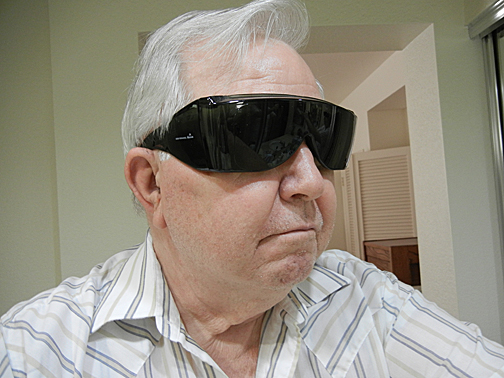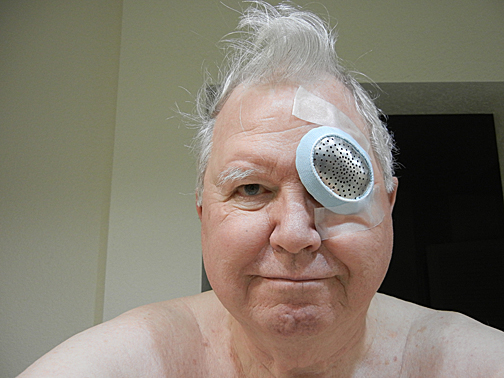A NEW OUTLOOK
As usual, I took a number and filled out the form. The DMV was not very busy so I only had minutes to wait. We took care of the paper work and the clerk turned on the box for the eye test. I was shocked when I looked in and had trouble making out the letters. The clerk was very patient with me, hinting that there were no two of the same letters on a line and that I should move my head around to see better. Somehow I passed and received a two-year driver’s license renewal.
I had a regular appointment scheduled in just a few weeks for my yearly eye
exam, so I looked forward to discussing the situation with my eye doctor.
She had previously indicated that I
was developing cataracts but that they probably didn’t need attention yet.
The new exam showed that the
cataracts were increasing, but she was still able to correct my vision with
glasses.
I was left with the feeling
that attention to the cataracts would depend on my discretion.
Driving in Maui is not very challenging.
I don’t think there is a road where one can legally exceed 50 or maybe 55
mph!
I’m familiar with most of my
destinations and I really don’t drive that much.
So I made a plan to test the effectiveness of my vision when I traveled
to California and Michigan in the spring.
High speeds and unfamiliar routes would provide the challenge I needed.
I guess you’d have to say I failed
miserably!
On freeways, the signs were not quite readable until it was too late to react.
In residential areas the street signs
were either too small or of such cryptic fonts that I couldn’t make them out.
I got lost several times.
It didn’t take long for me to decide that
my eyes needed attention before my next driver’s license renewal.
Upon return from the mainland, I simply went back to things as they were, but
readable signs kept getting closer to me.
Finally I got the notice for my annual eye check so I bit the bullet.
Instead of keeping the regular
appointment, I asked to see the cataract surgery specialist.
He did an evaluation and agreed that
it was time.
I was put in the
pipeline for “cataract extraction with intra ocular lens implant”, commonly
called “cataract surgery”.
This list illustrates the pipeline.
The dates are only significant to show the amount of time between appointments
2011-11-08 Cataract evaluation
2011-12-27 Measurements of both eyes for new lenses
2011-12-27 EKG – pre-op requirement
2012-02-01 Surgeon – pre-op for left eye
2012-02-08 Surgery on left eye
2012-02-08 Primary – check heart rate (anesthesiologist’s request)
2012-02-09 Surgeon – post-op (found abrasion on left eye)
2012-02-13 Surgeon – post-op II (to make sure abrasion was healing)
2012-02-27 Regular eye doctor – test of left eye
2012-02-27 Surgeon – check left eye/pre-op for right eye
2012-02-29 Surgery on right eye
2012-03-01 Surgeon – post-op
2012-03-20 Regular eye doctor – test of both eyes post-op
2012-03-20 Surgeon – check of both eyes post-op
2012-04-10 Primary – check heart rate (anesthesiologist’s request) and regular
6-mo
The pre-op appointment a week before surgery for the left eye consisted of a
final look at the left eye, an interview with questions about history and
general health, instructions leading up to the surgery, and prescriptions for
eye drops to be collected from the pharmacy and started the Sunday before
surgery.
On the day of the surgery I was to arrive fasting since midnight, had to have
arranged for delivery and pickup (no driving allowed), and had to allow for
about 2 hours at the clinic. As you
might expect there was an interview, more paperwork including an inventory of
possessions, and a verbal walkthrough.
I was installed in a bed in pre-op, vital sign monitors were hooked up,
and the usual IV was inserted (TKO).
A series of eye drops was started with a couple minutes between each drop.
While the drops were administered, the anesthesiologist came in, said normally
the procedure is done without anesthetic, but that I could have some if I
wanted.
I declined.
My vitals monitor was making noises
and he watched for a while. He was
concerned that my heart rate was low (35) and he ordered meds to speed it up a
bit and also made arrangements for me to see my primary after the surgery to
investigate the low rate.
The last “drop” before surgery was a sticky jell smeared all over to numb the
eye.
The surgery was almost
anticlimactic – it took about 10 minutes!
I could feel liquid sloshed across the eye a few times, but the knife and
other tools were barely perceptible.
The next day I drove to the clinic for post-op, wearing the big honking
wraparound glasses and closing my left eye most of the time.
I felt like there was a toothpick
under my eyelid.
While I was led to
believe the visual improvement would be almost immediate, I felt like I was
looking through smoke or a thin white sheet.
There
was a veritable blast of light, but not much detail.
I had trouble seeing the eye chart.
The surgeon looked me over and found
a “scratch” on the eye!
He said that
would cause what I was seeing. That
was a Thursday.
He was off on Friday
and the weekend, so he scheduled a post-post-op for Monday.
By Monday it had cleared a bit, but I
was really reluctant to have the second eye done.
As we talked about it, I came to understand that what he called a “scratch” was
really an extensive abrasion. That
made a little more sense to me, but I told him that I wanted to give it a week
or so before committing to the next surgery.
I promised to give him my go/no go one week before the next surgery.
As time went on, it cleared
completely and I sent an email and called his nurse to indicate that I was
ready.
|
|
|
|
|
^^ I’ve had “a couple” eye drops (more like a couple hundred)
<< I’ve seen a few eye charts (but every time I try to memorize they change the chart) |
Eye charts and the paddles to cover one eye and the paddles with little holes
were a common feature of my doctor visits.
I estimate that each eye endured well over 200 eye drops over this
period, with nearly 200 self-administered.
The listing above is one page of the record of drops on one surgery day.
The little bottles are the
prescriptions for home use.
I started out feeling lucky if I could get the drops somewhere on the proper
side of my face, but soon got so I could find the mark most of the time.
One of the drops had to be used for
only two weeks.
The other
prescription had to be used until it was gone.
It wasn’t until the bottle was almost empty that I realized dripping it
on my cheek meant it would run out sooner – of course I didn’t do anything with
that knowledge (consciously).
|
|
|
|
|
|
|
Wrap-around
sun protection |
Shield for
protection while sleeping |
After surgery the affected eye was supersensitive to light. The wraparound shades did a good job
during that period – especially when driving.
The shield was used for sleeping when covers or uncontrolled fingers
could damage the eyes.
After the left eye was done and before the right eye,
I was in the
middle ground of vision. Left eye
was slowly returning to usability.
Right eye was as it was - still obscured by the cataracts. Glasses didn’t really fit either eye. Brain was totally confused by the
WASH of bright white light input by the left and the yellowish input by the
right and the lack of correction by the glasses.
In fact, one day halfway through my morning walk in the pre-dawn I
removed my glasses and did better without them after that!
I went to the local eye clinic and had the left lens popped out of my regular
glasses. That better served my need
to drive by allowing me to keep both eyes open, but didn’t help with reading. I got along by squinting, selectively
closing an eye, and laughing at myself.
|
|
|
|
|
|
|
Camera &
right eye with original equipment |
Left eye
with replacement lens |
I had a chance to experiment with the differences. Color differences were incredible. The bush shown above just amazed me. The camera agreed with my right eye
with the cataracts. The new lens in
my left eye presented my brain with purple flowers. I talked to a young lady at that bush
and she saw purple like my new eye.
I talked to an older man there and he saw the maroon like my old eye. I took a clipping of the bush and the
above pics to the clinic and not only got differences from each person, but I
saw differences depending on the lighting.
Not a very scientific investigation, but I found it fascinating. If anyone had seen me standing in
front of that bush blinking at it, I’m afraid they might have summoned the men
in white coats.
The right eye pre-op, readying on op day, and op itself were pretty much the
same, except that I warned the surgeon not to think about zebras. The surgery went fine. They put the vitals monitors on me,
but never plugged them in.
Post-op the next day went fine. I
drove there with the wraparounds but without glasses. I could see the eye chart easily up
to the 20/25. There was no
indication of scratches. The surgeon
agreed that thinking of zebras must have been the problem.
Dr. explained the surgery. A 2.7mm
slit is made at the bottom of colored part of the eye. A device is inserted
through the slit into the pita pocket that contains the lens. Device whips the lens to break it up
and sucks it out. Tiny tube
containing new folded lens is threaded into pita and lens is inserted. Lens magically unfolds. Eye is left to heal - no stiches,
glue, staples, duct tape or the like.
Lots of drops - before, during, after, and for next few weeks. This link and many others illustrate
the procedure.
http://www.allaboutvision.com/conditions/cataract-surgery.htm#csv
SUMMARY
The entire experience is amazing.
That these relatively short procedures can immediately provide such dramatic
improvements is almost miraculous.
The scratch on the left cornea scared me but that apparently happens
occasionally. The right eye was
totally improved directly out of the operating room.
I’m writing this several weeks after the second op. I no longer wear my old prescription
bi-focal glasses and have purchased granny glasses for reading. The grooves in my temples made over
the years by the earpieces of glasses are starting to flatten out, which will
undoubtedly please my barber. I need
to get more appropriate sunglasses and that should close this experience. I should probably start practicing
for the driver eye test coming up on my next birthday, but I don’t expect to
have any problem – I test 20/20 in both eyes.
|
AFTERWORD
I am very happy with the results of cataract surgery.
I can actually hear much better now and I think my hair is starting to
grow back!
I was instructed not to lift anything heavier than 15# and not to do anything strenuous
like housework for at least 2 weeks after each surgery. In an abundance of caution I have
decided to extend that period to 6 months.
I told my kids they gave me medication to increase my heart rate, but this is what
actually happened. My Medicare and
personal insurance coverage is pretty good, but you should see the co-pay on
that procedure! |
|
|
|
|






